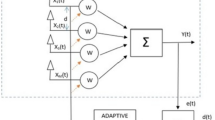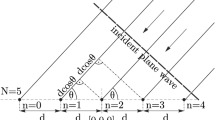Abstract
This paper describes a blind cochannel interference cancelling technique, indirect cochannel interference cancelling (ICIC), that cancels a constant envelope modulated interferer in cellular mobile radio communication channels. ICIC exploits the constant envelope property of the interfering signal to simplify the receiver structure. The basic concept of ICIC and the possible receiver structures are discussed. The performance of a ICIC receiver in practical channels as well as its sensitivities to the channel parameters are investigated by simulation.
Similar content being viewed by others
References
K. Girindhar, S. Chari, J.J. Shynk and R.P. Gooch, “Joint Demodulation of Cochannel Signals Using MLSE and MAPSD Algorithms”, in IEEE International Conference on Acoustics, Speech and Signal Processing, Minneapolis, Minnesota, U.S.A., April 1993, pp. 160–163.
K. Girindhar, S. Chari, J.J. Shynk, R.P. Gooch and D.J. Artman, “Joint Estimation Algorithms for Cochannel Signal Demodulation”, in IEEE International Conference on Communications, Geneva, Switzerland, May 1993, pp. 1497–1501.
P.A. Ranta, A. Hottinen and Z. Honkasalo, “Co-Channel Interference Cancelling for TDMA Mobile Systems”, in IEEE International Conference on Communications, Seattle, Washington, U.S.A., June 1995, pp. 17–21.
H. Yoshino, K. Fukawa and H. Suzuki, “Interference Cancelling Equalizer (ICE) for Mobile Radio Communications”, in IEEE International Conference on Communications, New Orleans, U.S.A., May 1994, pp. 1427–1432.
S.W. Wales, “Technique for Cochannel Interference Suppression in TDMA Mobile Radio System”, IEE Proc. Communication, Vol. 142, pp. 106–114, 1995.
J.B. Anderson, T. Aulin and C.E. Sundberg, Digital Phase Modulation, Plenum Press: New York, 1989.
J.R. Treichler and B.G. Agee, “A New Approach to Multipath Correction of Constant Modulus Signals”, IEEE Trans. on Acoustic, Speech, and Signal Processing, Vol. ASSP-31, pp. 459–472, 1983.
T. Ohgane, T. Shimura, N. Mutsuzawa and H. Sasaoka, “An Implementation of a CMA Adaptive Array for High Speed GMSK Transmission in Mobile Communications”, IEEE Transaction on Vehicular Technology, Vol. 42, pp. 282–288, 1993.
B. Hagerman, “Downlink Relative Co-Channel Interference Powers in Cellular Radio Systems”, in IEEE Vehicular Technology Conference, Chicago, Chicago, U.S.A., July 1995, pp. 366–370.
G.D. Forney, “The Viterbi Algorithm”, Proc. of the IEEE, Vol. 61, pp. 268–278, 1973.
I.B. Ball, “A Real Time Fading Simulator for Mobile Radio”, The Radio Electronic Engineer, Vol. 52, pp. 457–478, 1982.
W. Feller, An Introduction to Probability Theory and Its Applications, John Wiley and Sons: New York, 1957.
R. Prasad, CDMA for Wireless Personal Communications, Artech House: Boston, 1996.
D.W. Paranchych and N.C. Beaulieu, “Digital Symbol Synchronizer Performance in the Presence of Multiple Cochannel Interferers”, in 7th Canadian Conference on Electrical and Computer Engineering, Halifax, Canada, Sept. 1994, pp. 284–287.
Author information
Authors and Affiliations
Rights and permissions
About this article
Cite this article
Berangi, R., Leung, P. Indirect Cochannel Interference Cancelling. Wireless Personal Communications 19, 37–55 (2001). https://doi.org/10.1023/A:1011956224541
Issue Date:
DOI: https://doi.org/10.1023/A:1011956224541




